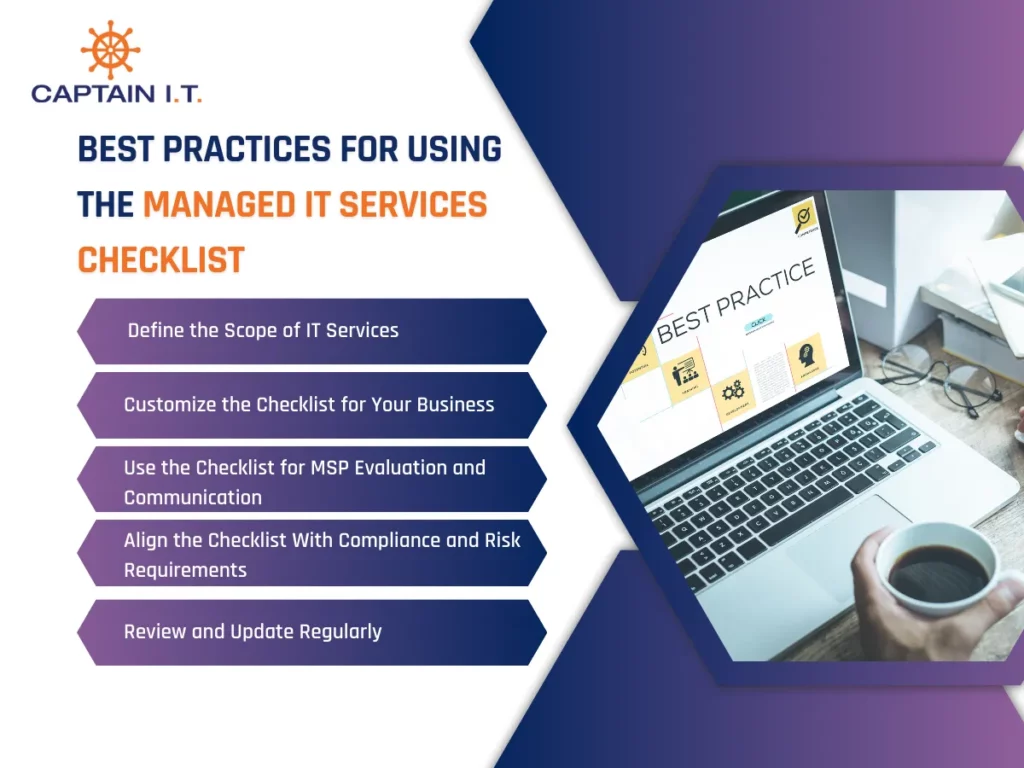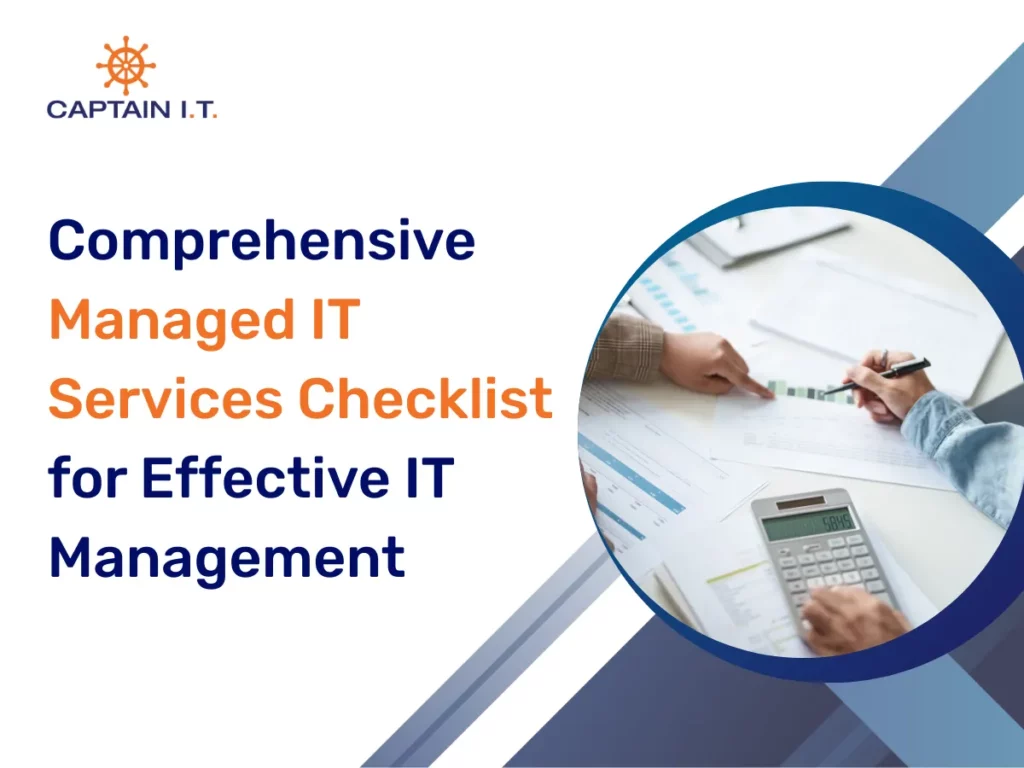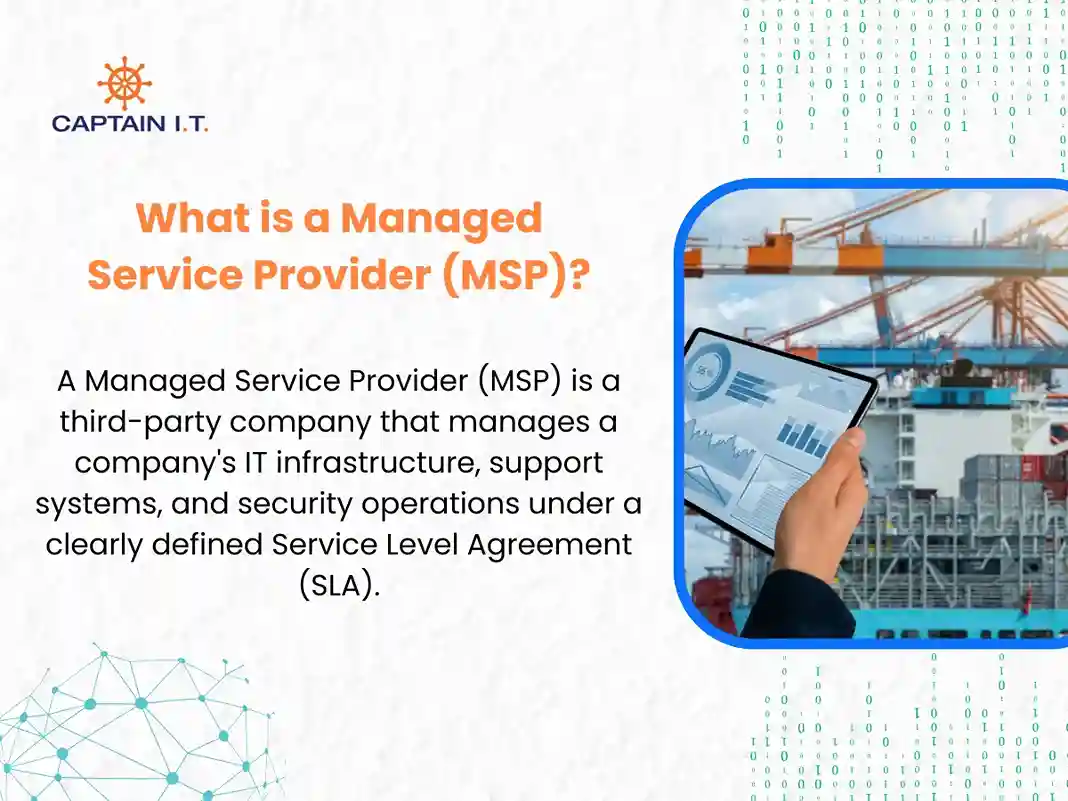A managed IT services checklist is a structured framework that outlines all essential IT functions a business needs to monitor, secure, and manage its technology environment effectively. From cybersecurity protection and disaster recovery planning to performance monitoring and compliance alignment, the checklist ensures that no critical area is overlooked. It acts as a clear roadmap for businesses aiming to maintain operational continuity, strengthen security measures, and improve long-term IT performance.
Selecting the right managed services provider (MSP) starts with using this checklist to evaluate expertise, service scope, response times, and compliance capabilities. A well-chosen MSP must align with the checklist’s criteria, offering transparent service level agreements (SLAs), proactive infrastructure management, and dedicated support that matches the business’s unique operational needs. Choosing a provider without a structured checklist often leads to service gaps and higher long-term risks.
Why is the Managed IT Services Checklist Important?
The managed IT services checklist is important for ensuring consistency, accountability, and thoroughness in IT service delivery. It provides a structured and specific framework for selecting the right external service provider (MSP) that can help businesses align IT activities with their core objectives for better output.
Below are the top 8 reasons highlighting the importance of a managed IT services checklist.
- Provides a clearly defined service scope, outlining every technical responsibility and expectation.
- Improves vendor communication by using structured checklist questions to evaluate MSP performance.
- Supports compliance by ensuring IT activities adhere to regulatory and security standards.
- Enhances risk management with built-in disaster recovery planning and threat monitoring strategies.
- Facilitates continuous improvement by providing a basis for regular review and service optimization aligned with long-term goals.
- Helps prioritize investments by identifying critical IT infrastructure needs based on performance data.
- Ensures measurable accountability through transparent service-level agreements (SLAs) and performance reporting.
- Streamlines vendor evaluation during MSP selection by aligning checklist criteria with business-specific IT requirements.
What Are The Core Components of a Managed IT Services Checklist?
The core components of a managed IT services checklist include core IT support, performance monitoring, cybersecurity services, network management, backup and disaster recovery, user and device management, cloud productivity tools, and compliance reporting. These essential elements ensure strategic, secure, and continuous management of a business’s entire IT infrastructure.

Core IT Support
Ensuring seamless operations begins with a strong core IT support, providing businesses with immediate assistance to resolve technical issues and maintain uptime.
- Availability of a 24/7 help desk support
- Remote and on-site support coverage
- A well-defined and documented Service Level Agreement (SLA)
- Dedicated support ticketing system
- Clear escalation paths for unresolved issues
Performance Monitoring and Reporting
With active performance monitoring and reporting, businesses can detect performance issues before they escalate and disrupt operations.
- Real-time monitoring of servers, applications, and networks.
- Regular delivery of performance reports.
- Configured alerts to detect and address anomalies quickly.
- Continuous analytics to support infrastructure optimization.
Cybersecurity Services
A comprehensive cybersecurity service protects business assets by detecting and responding to evolving digital threats.
- Firewall and antivirus management
- Patch management for all systems
- Endpoint protection monitoring
- Email filtering and phishing protection
- Multi-factor authentication (MFA) implementation
- Dark web monitoring for compromised credentials
Network Monitoring & Management
Through proactive network monitoring and management, businesses can avoid operational disruption while maintaining service quality.
- Proactive monitoring of servers and workstations
- Implementation of network performance monitoring tools
- Configured alerts for outages or anomalies
- Routine network assessments and health checks
Backup & Disaster Recovery
Businesses require effective backup and disaster strategies to ensure rapid restoration and minimal downtime after an incident.
- Regular backups for critical data (daily/hourly, where applicable)
- Proper deployment of cloud and/or off-site backup solutions
- Periodic testing of disaster recovery plans
- Defined Recovery Time Objectives (RTO) and Recovery Point Objectives (RPO)
User & Device Management
By controlling user access and maintaining device integrity, businesses can achieve enhanced security, improved IT efficiency, and better user experience.
- Onboarding/offboarding processes for users
- Asset inventory and device lifecycle tracking
- Utilization of Mobile Device Management (MDM) solutions
- Standardized software image deployment
Cloud & Productivity Tools
Efficient management of cloud and productivity tools ensures enhanced collaboration, scalability, project management, and cost savings.
- Microsoft 365 or Google Workspace management
- Deployment of cloud file storage and sharing solutions
- Regular review of cloud security configurations
- Provision of user training on the collaboration tools
Compliance & Reporting
Businesses can maintain strong regulatory standards and achieve IT transparency through strong compliance and reporting systems.
- Monthly or quarterly IT performance reports delivered
- Defined security incident reporting procedures
- Compliance alignment with HIPAA, CMMC, PCI-DSS, etc.
- Regular end-user cybersecurity training sessions
What Are The Best Practices for Using the Managed IT Services Checklist?
The best practices for using the managed IT services checklist involve a clearly defined scope of IT services, strategic customization, continuous evaluation, and clear alignment with business goals and compliance standards. Following these proven techniques makes the checklist a critical, effective, and responsive tool for managing IT services.

- Define the Scope of IT Services
By clearly outlining the scope of IT services, businesses can document the services they expect from an MSP. It includes everything from basic IT support to advanced cybersecurity services. Defining the scope also helps assign roles and responsibilities, making the checklist transparent and specific for internal teams and external providers. - Customize the Checklist for Your Business
Tailor the checklist to your company size, industry, and operational priorities. A customized checklist captures unique needs such as compliance requirements, disaster recovery planning, or mobile device management strategies for your infrastructure. - Use the Checklist for MSP Evaluation and Communication
A detailed checklist is a great tool for evaluating and communicating with MSPs. During evaluation, businesses can match provider capabilities to specific checklist questions, ensuring service level agreements (SLAs), response time, and support strategies align with business objectives. - Align the Checklist With Compliance and Risk Requirements
Including compliance requirements in the checklist confirms that IT services support your organization’s compliance with HIPAA, PCI-DSS, or CMMC standards. It also strengthens risk management by facilitating incident reporting, data encryption, and threat detection. - Review and Update Regularly
Regular reviews keep the checklist flexible and updated with new technologies, cyber threats, and organizational changes. By consistently updating the checklist, businesses stay relevant, improve service performance, and address newly identified critical infrastructure needs.
What Are the Most Common Challenges Small Businesses Face in Managing IT, and How MSPs Help Address Those Challenges?
The most common challenges small businesses face in managing IT are limited resources, cybersecurity vulnerabilities, fluctuating performance monitoring, poor disaster recovery planning, compliance and regulatory risks, outdated infrastructure, and slow response to IT issues. The hindrances disrupt business operations and increase security risks, increasing the chance of data breaches, theft, and reputational damage. Partnering with MSPs helps businesses address these obstacles by implementing targeted solutions.
Below are the 7 common challenges SMBs experience while managing IT, along with the methods to address them.
- Limited IT Resources: SMBs operate with limited budgets, making it challenging to maintain their IT infrastructure. With limited IT resources, they lack the necessary expertise to compete in the market. By partnering with MSPs, SMBs get 24/7 help desk support and dedicated technical teams without hiring an entire in-house IT team.
- Cybersecurity Vulnerabilities: Gaps in network, infrastructure, and system security expose businesses to threats like phishing attacks and data breaches. Hiring an MSP empowers SMBs with advanced cybersecurity services like firewall management, endpoint protection, email filtering, access control, and dark web monitoring for continuous protection.
- Inconsistent Performance Monitoring: When businesses are left unmonitored, they experience unnoticed system slowdowns and unexpected failures, leading to increased downtime and service disruptions. SMBs securing the help of an MSP get access to proactive performance monitoring tools that detect and resolve issues before they cause operational impact.
- Poor Disaster Recovery Planning: SMBs without proper disaster recovery planning face critical data loss and increased downtime during emergencies like system malfunction, cyberattacks, and natural disasters. Seeking MSP’s assistance enables efficient management of backup and disaster recovery solutions, including defining Recovery Time Objectives (RTO) and Recovery Point Objectives (RPO) for minimal downtime.
- Compliance and Regulatory Risks: Failure to meet regulatory standards like HIPAA or PCI-DSS risks SMBs to legal disputes, reputational damage, and a halt in operations. Tasking MSPs with adherence to compliance and regulatory requirements ensures proper documentation, effective incident reporting processes, and regular cybersecurity training for users, allowing business owners to operate in complete confidence.
- Outdated Infrastructure: SMBs with legacy infrastructure and systems expose businesses to vulnerabilities. Frequent maintenance increases operational costs, adding an additional burden to an already restrained IT budget. Involving MSPs helps businesses modernize infrastructure effectively and smoothly. They also assist in upgrading hardware, optimizing network setups, and maintaining secure environments.
- Slow Response to IT Issues: Businesses that are slow in responding to IT issues cause prolonged downtime and increase frustration among employees. So, hiring an MSP for resolving IT issues in a minimal duration helps improve incident resolution times. They implement strategic escalation and immediate expert intervention, ensuring swift issue resolution, decreased downtime, and enhanced business productivity.
How Can Implementing a Managed IT Services Checklist Help Ensure Effective IT Management?
A managed IT services checklist ensures effective IT management by organizing critical managed IT solutions such as cybersecurity, performance monitoring, backup, and compliance into a clear, actionable framework. It helps businesses reduce downtime, strengthen security, meet regulatory requirements, and maintain consistent IT performance through proactive tracking and structured service delivery.
Captain IT, a reliable managed services provider, offers tailored managed IT solutions aligned with business needs, ensuring continuous support, secure infrastructure management, and compliance-driven operations. Our checklist-driven approach helps businesses optimize IT performance and achieve sustainable growth with strategic, responsive services.



